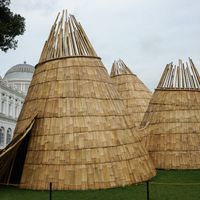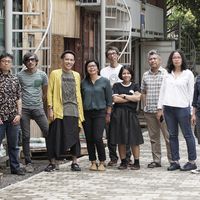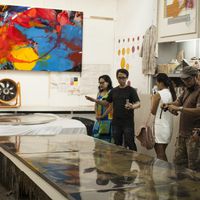Singapore Biennale 2013 | In Conversation with Tan Boon Hui
 [caption id="attachment_40008" align="alignleft" width="300"]
[caption id="attachment_40008" align="alignleft" width="300"]Bharti Lalwani speaks to Tan Boon Hui, SB2013 Project Director and Co-Curator and former director of the Singapore Art Museum, who initiated and spearheaded the biennale collaboration between 27 curators from around Southeast Asia for the 4th Singapore Biennale which explored the potent theme "If the World Changed".
(Key: TBH: Tan Boon Hui, BL: Bharti Lalwani)
BL: Let's start with the premise of this biennale which solely focuses on art practices around Southeast Asia. Does the geneology of this year's biennale bear its roots in the exhibition you co-curated with critic Iola Lenzi- Negotiating Home, History, Nation (NHHN) which ran as a parallel exhibition to the 2011 Singapore Biennale?
TBH: By the time I was asked if the Singapore Art Museum could take over the organization of the 3rd Singapore Biennale in 2010, the curators had been appointed and the biennale title selected for all intents and purposes but I was troubled by the whole issue of what a biennale in a place like Singapore should be and which public would it be created for. The question of how a biennale could have value beyond the frankly small coterie of ‘biennale professionals’ such curators, critics, academics, gallerists and collectors was always a perpetual challenge.
While I could not retool the structure of the 3rd biennale, it was possible to experiment with other possibilities at the fringes, especially with parallel projects. Two years prior to this, the independent curator Iola Lenzi pitched a proposal for a survey exhibition on contemporary Southeast Asian art when I was at the National Museum of Singapore. The occasion of 3rd biennale in 2011 therefore seemed the perfect opportunity to realize this project as a sort of testbed for making a statement about the region that was grounded in the social-political history of the last 20 years, as well as an attempt to make larger statements about the strength of regional art. So we had Iola Lenzi as guest curator, and Khairuddin Hori and myself as co-curators. The show was very popular and people were surprised at its intense, provocative content.
In writing my essay for the catalogue of this exhibition Negotiating Home, History and Nation, I started to make preliminary propositions about the art of Southeast Asia, ways in which we could connect the disparate cultures and art practices. In this sense, the curating structure and regional focus of this 4th Singapore Biennale, for me at least, did have roots in this smaller experiment during the last biennale.
When I was asked by the National Arts Council to propose the 2013 edition of the biennale, I therefore suggested a new model for the next Biennale that would give it a distinct identity, ie Southeast Asia focus, from that of our Asian biennales such as Gwangju Biennale, Shanghai Biennale and Yokohama Triennale. The thinking was also to bring a freshness to the conventional biennale, which frequently shows artists who have already been featured in other biennales or international exhibitions. The wider Asian art scenes such as Japan and Korea became the next level of consideration, if appropriate. This regional approach is not limiting, as all the forms and discourses of contemporary art are found within the region. Instead, it will allow us to surface more diverse practices across the region.
BL: At the time I reviewed both the Biennale and this major survey exhibition, I thought NHHN- in itself a micro-biennale, was way more comprehensive- the catalogue essays on their own were quite exhaustive. For this biennale, I liked that there were a number of new works and in that sense it was fresh. We've already seen how the same works circulate through a number of biennales.
How did you aim to provide an expansive overview of the region's diverse art practices within "If the world changed"?
TBH: NHHN achieves it power via concentration, an intense experience, deeply excavated and in your face. Most of the artists, were established and we looked for representational works that could be canonical over time. The unremitting focus on the role of the artwork as social commentary and critique also gave NHHN an ethical core that tied works together.
This biennale, however, aims for freshness and openness, even at the risk of unevenness in the presentation. The format builds in the possibility of idiosyncratic selections, rather than sure winners. A key focus for this Biennale was to look across the region and allow visitors access to not just more internationally known artists from places like Indonesia and Philippines but also artists from the mainland like Myanmar, Cambodia and Laos as well as artists from outside the major metropolitan art centres in the region. This biennale can be seen as an attempt at mapping the practices of the region and sometimes when you do that, you have to concede some ability to do deep into one particular issue or scene.
My concern was more that people did not even have a good sense of the artistic configuration or practices in the region will be coming to the biennale and the exhibition needed also to take seriously its role in educating our audiences about this region. What we had to sacrifice was the time to interrogate the differences between our curatorial strategies and how they relate to the current state of art-making in their specific locality. The theoretical framework for hanging all these concepts on is still to be made. That would be the challenge I would lay out for the next biennale, to tease out the interconnections and gaps between the practices in the region. When curators and art historians write about biennales, they often forget the context of the public that is experiencing this biennale which often results in the embarrassing ways in which even senior writers describe exhibitions such as the biennale without even mentioning how the general public outside the coterie of professional art specialists is encountering the artworks. I firmly believe that curators and organisers of Biennales in developing art scenes need to learn to speak of art beyond what Camille Paglia calls “the echo chamber of current art discourse”.
To achieve this, our curatorial model of 27 co-curators was key. The curators were picked for their own regional capabilities and specialised knowledge of their respective region or country’s contemporary art scene. Some of their practices are interdisciplinary in nature, some of them run independent art spaces, some more known as artists. For example, from Vietnam, we have Tran Luong, known for his works in video and performance, who is also a curator and hails from Hanoi, in the north of Vietnam.
Alongside we have Nguyen Nhu Huy, an interdisciplinary artist who also curates and writes and is the artistic director of Zerostation based in Ho Chi Minh City, in the south of Vietnam. From Malaysia, we have Yee I-Lann, a multi-disciplinary artist originally from East Malaysia; while from the Philippines, we have Kawayan de Guia from Baguio in the north of Luzon, Charlie Co who has keen interest in practitioners from the Visayas Islands, and Abraham Garcia Jr. who is based in Mindanao. Collectively, all 27 of us were able to bring SB2013 together to present a layered picture of Southeast Asian contemporary art, reflecting the wide-ranging practice and thinking from this region.
BL: So what were the criteria for selection of the 27 curators from within Singapore and Southeast Asia? - And how does the democratic process of deliberation take place among this unusual number of collaborators?
TBH: The 27 co-curators were invited to be part of the Biennale for their distinct local knowledge of regional art practices, differing perspectives and specific networks and expertise of contemporary art practice that span beyond major metropolitan centres in the region. Southeast Asia is such a vast and diverse region it was impossible to find one person who had all the connections. As such, we saw an opportunity to bring together and build relationships between artists, practitioners and curators across the region to create a truly ground-breaking and distinctive international Biennale. Once we all got together we knew that the collaborations were right and insightful, as the curatorial team had identified numerous names that the international community will not have heard of before, or artworks that are not presented on other international platforms.
Artist selection is both an art and a science. All 27 curators came to meetings with mutual respect for each other. We all benefitted from learning about each other’s work and the artists presented. Discussions focused on the strength and rigour of proposals, and each artist’s practice and decisions are eventually arrived at based on majority consensus. We did not necessarily agree on everything but enough to move ahead. If there was more time, it would have been wonderful to be able to move the curatorial discussions more deeply into issues where we diverged and see where it took us. I personally think that is what a biennale should be, leave questions and opportunities for others to take up, rather than simple statements of finality.
BL: Were the artists given a clear and well defined direction from the curators or perhaps you took a more spontaneous approach?
TBH: The artists were shortlisted for the strength of their proposals and relevance to the title If the World Changed. Beyond that the curators individually had their own style of working and we respected those differences.
BL: At the press conference, you talked about how the discussion on the theme began with 'What do we not know?' - Were there any significant knowledge gaps within Singapore Art Museum's archival research on contemporary practices?
TBH: Academics and curators love to use this term ‘research’, but often too loosely. Artists are much too creative to be pigeonholed and there was no way any one curator could fly in and out on short field trips and end up with any deep understanding especially of scenes that are complex and have many players.
That horrible term ‘research-based curating’ does not really get one anywhere. That’s where curators often ignore the established methodology of anthropologists who are the true champions of authentic field research, living and breathing with their subjects over a sustained period of time. For this biennale, we were tapping upon the years of immersion that each of our invited co-curators have in their local scenes, something that the museum could not replicate at the present moment. That is where the deep knowledge originates.
BL: Most of the funding comes from National Arts Council (NAC). As I understand, SGD 6 Million has been the official figure since 2008 (SGD 4 Million + 2 Million Private Funds in 2006); For this Biennale edition, you utilize existing spaces such as the elegant Peranakan Museum, The National Museum and Singapore Art Museum - This considerably frees up the budget for new concepts and commissions…
What were your challenges with this ambitious and commendable biennale and how do you think this edition succeeds?
TBH: The budget for this biennale has remained similar to the previous installment. What we have managed to do is to present more artists across more venues than the previous two editions (82 artists and 9 venues), this edition also saw an increased percentage of commissions. Significantly higher than previous years at 82%, this marks the highest percentage to date. Through this commissioning, SB2013 enabled artists from the region the opportunity to expand their practice.
What’s worth noting is that we have been able to commission a diverse range of artworks including work from artists who work with local communities . One example would be Singapore’s Ahmad Abu Bakar, whose work Telok Blangah features a traditional wooden Malay boat, filled with 1000 glass bottles inscribed with messages collected from male inmates of the Singapore Prisons. Messages in the bottle describe the hope and aspirations of the inmates while in incarceration and upon their release. In this work, art, as a way of communication, becomes tangible when the public is offered an opportunity to leave messages that would be taken back to the inmates. While it is seemingly direct and yes- naïve, the simplicity of the offering in this case brings an honesty that is missing in much conceptual art.
This year we were also sure to invest in other programming efforts that have allowed deeper engagement with audiences. For instance, we have a number of themed curator tours available as well as a variety of interactive artist workshops that give the public access to the people behind the Biennale works. Other resources include a SB2013 smartphone app that offers two specially curated time-based walking trails as well as detailed Artist Folios designed for educators and parents to provide a background to the artist and their work, along with a glossary of terms, suggested questions, and activities to encourage children of all ages to understand each work and its themes.
Links and references
- Singapore Biennale: http://www.singaporebiennale.org/
- Negotiating Home History Nation: Two Decades of Contemporary Art in Southeast Asia 1991-2011: http://www.aaa.org.hk/Collection/Details/43795
Similar content
30 Jan 2012
from - to
26 Oct 2013 - 16 Feb 2014






